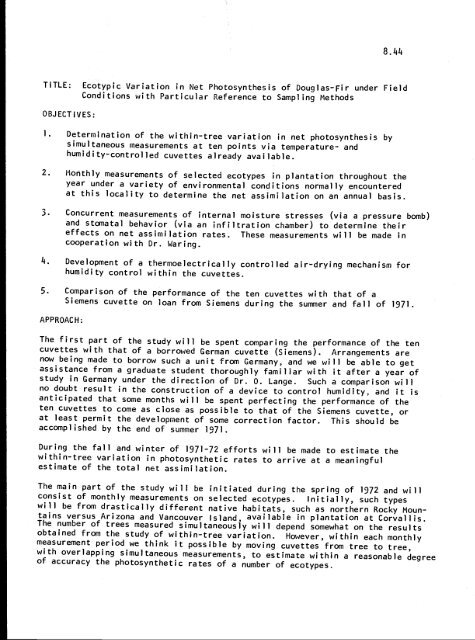FOREST BIOME - ScholarsArchive at Oregon State University
FOREST BIOME - ScholarsArchive at Oregon State University
FOREST BIOME - ScholarsArchive at Oregon State University
Create successful ePaper yourself
Turn your PDF publications into a flip-book with our unique Google optimized e-Paper software.
8.44<br />
TITLE: Ecotypic Vari<strong>at</strong>ion in Net Photosynthesis of Douglas-Fir under Field<br />
Conditions with Particular Reference to Sampling Methods<br />
OBJECTIVES:<br />
1. Determin<strong>at</strong>ion of the within-tree vari<strong>at</strong>ion in net photosynthesis by<br />
simultaneous measurements <strong>at</strong> ten points via temper<strong>at</strong>ure- and<br />
humidity-controlled cuvettes already available.<br />
2. Monthly measurements of selected ecotypes in plant<strong>at</strong>ion throughout the<br />
year under a variety of environmental conditions normally encountered<br />
<strong>at</strong> this locality to determine the net assimil<strong>at</strong>ion on an annual basis.<br />
3. Concurrent measurements of internal moisture stresses (via a pressure bomb)<br />
and stom<strong>at</strong>al behavior (via an infiltr<strong>at</strong>ion chamber) to determine their<br />
effects on net assimil<strong>at</strong>ion r<strong>at</strong>es. These measurements will be made in<br />
cooper<strong>at</strong>ion with Dr. Waring.<br />
4. Development of a thermoelectrically controlled air-drying mechanism for<br />
humidity control within the cuvettes.<br />
5. Comparison of the performance of the ten cuvettes with th<strong>at</strong> of a<br />
Siemens cuvette on loan from Siemens during the summer and fall of 1971.<br />
APPROACH:<br />
The first part of the study will be spent comparing the performance of the ten<br />
cuvettes with th<strong>at</strong> of a borrowed German cuvette (Siemens). Arrangements are<br />
now being made to borrow such a unit from Germany, and we will be able to get<br />
assistance from a gradu<strong>at</strong>e student thoroughly familiar with it after a year of<br />
study in Germany under the direction of Dr. 0. Lange. Such a comparison will<br />
no doubt result in the construction of a device to control humidity, and it is<br />
anticip<strong>at</strong>ed th<strong>at</strong> some months will be spent perfecting the performance of the<br />
ten cuvettes to come as close as possible to th<strong>at</strong> of the Siemens cuvette, or<br />
<strong>at</strong> least permit the development of some correction factor. This should be<br />
accomplished by the end of summer 1971.<br />
During the fall and winter of 1971-72 efforts will be made to estim<strong>at</strong>e the<br />
within-tree vari<strong>at</strong>ion in photosynthetic r<strong>at</strong>es to arrive <strong>at</strong> a meaningful<br />
estim<strong>at</strong>e of the total net assimil<strong>at</strong>ion.<br />
The main part of the study will be initi<strong>at</strong>ed during the spring of 1972 and will<br />
consist of monthly measurements on selected ecotypes. Initially, such types<br />
will be from drastically different n<strong>at</strong>ive habit<strong>at</strong>s, such as northern Rocky Mountains<br />
versus Arizona and Vancouver Island, available in plant<strong>at</strong>ion <strong>at</strong> Corvallis.<br />
The number of trees measured simultaneously will depend somewh<strong>at</strong> on the results<br />
obtained from the study of within-tree vari<strong>at</strong>ion. However, within each monthly<br />
measurement period we think it possible by moving cuvettes from tree to tree,<br />
with overlapping simultaneous measurements, to estim<strong>at</strong>e within a reasonable degree<br />
of accuracy the photosynthetic r<strong>at</strong>es of a number of ecotypes.
















